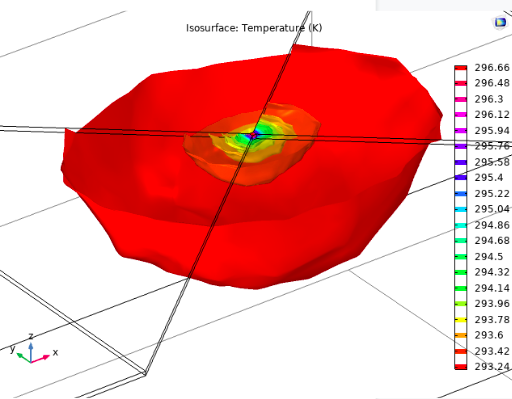Thermal Expansion Measurements
A nanoscale structure machined in a silver thin film (50 nm) can be used as an active plasmonic element whose plasmonic response can be modulated via applied current. When a current is applied the silver heats up changing its refractive index and consequently the optimal angle at which resonance occurs. To characterise this active element it is necessary to measure the temperature of the surface. Modulating the element with an alternating current causes the element to expand and contract periodically. Using an atomic force microscope this expansion cycle can be captured while measuring the topography of the surface. A lock-in amplifier can then be used to extract the expanded surface from a scan performed while modulating the element. This allows us to map the expansion due to Joule heating of the metallic film. A temperature distribution can be obtained and the temperature of the surface can be inferred from this expansion data.

COMSOL Simulations
COMSOL multiphysics is a finite element analysis simulation software with fully coupled multiphysics and single-physics modelling capabilities. FEM simulations are used to help design the nanostructure that constitutes the core of the PEAR imaging method and to provide a solid backup to the results obtained experimentally. The possibility to couple electrical, mechanical, and thermal aspects is exploited to model and compare different nanostructure geometries, while a combination of the optical and thermal modules allow confirmation of changes in the SPR curves obtained through the Angularly Resolved SPR experiment.

Enhanced Angular SPR
A new method enables the generation of modified surface plasmon resonance (SPR) curves allowing access to previously undetected features. Alternating currents are used to change the properties of a metal thin film-dielectric interface at kilohertz frequencies causing measurable alterations in the classical SPR curve properties. Curves are generated by exciting SPPs at the interface for a range of angles about the SPP angle. However, here, a novel approach of modulating the temperature during the angular scan results in a new type of SPR curve. Precise angular increments give rise to high resolution which aids in detailed analyses of these new curves. The analysis of these curves provides a broad range of possible characterisations, highly useful in future active plasmonic sensor technology, including PEAR.

Precision Distance Measurements Using Fabry-Pérot Cavities
Fabry-Pérot interferometer (FPI) or etalon is an optical cavity made from two parallel reflecting surfaces (i.e. thin mirrors). Optical waves can pass through the optical cavity only when they are in resonance with it. Charles Fabry and Alfred Perot, who developed the instrument in 1899. We use this property to construct a high-resolution spectroscopy tool with extremely narrow free spectral range which is tunable by changing the properties of the mirrors used in the cavity.


